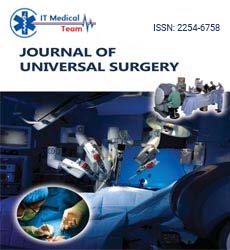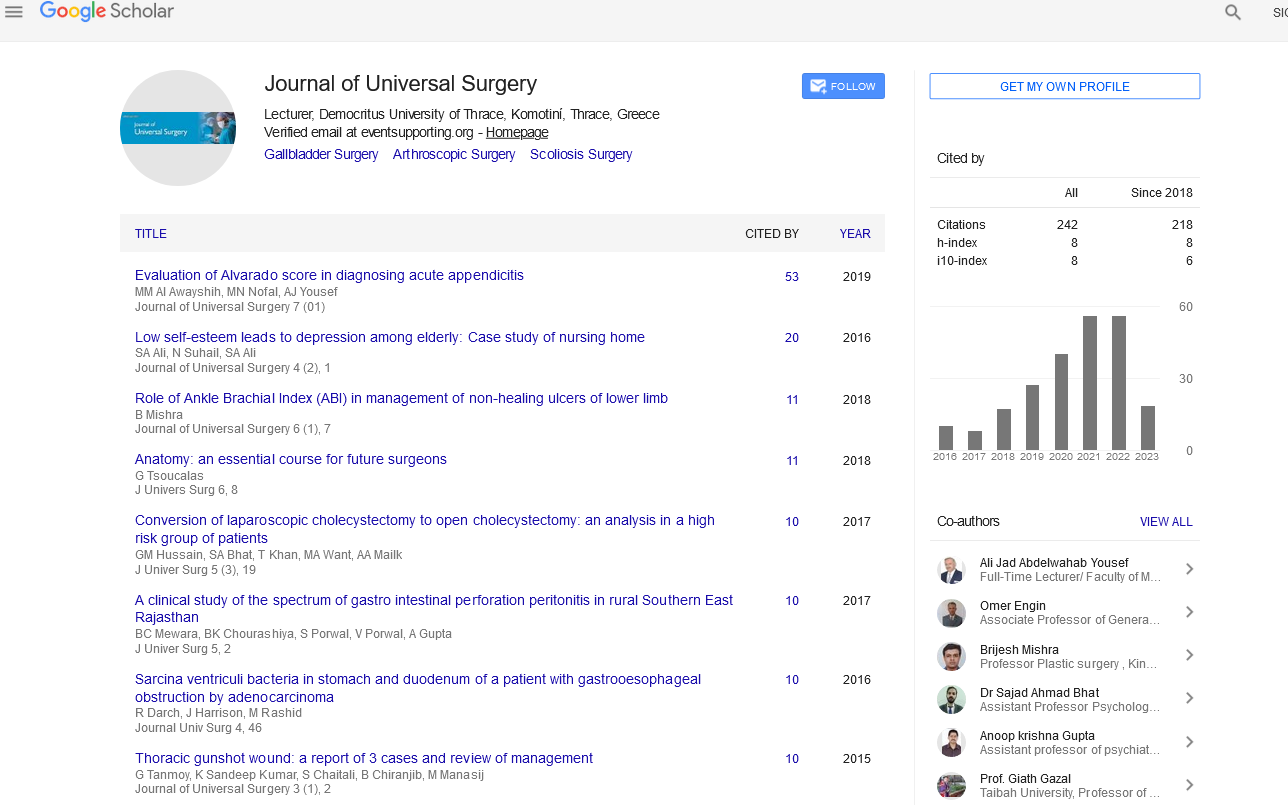Mini Review - (2023) Volume 11, Issue 4
Unprotected left main angioplasty in the elderly at a High Flow Catheter Center without an on-site surgical facility: Immediate and intermediate results - The Old Placet Registry
Gagnor Alia*
Department of Surgery, University of Turin, Italy
*Correspondence:
Gagnor Alia, Department of Surgery, University of Turin,
Italy,
Email:
Received: 03-Apr-2023, Manuscript No. IPJUS-23-13581;
Editor assigned: 05-Apr-2023, Pre QC No. IPJUS-23-13581;
Reviewed: 19-May-2023, QC No. Q-13581;
Revised: 21-Apr-2023, Manuscript No. R-13581;
Published:
28-Apr-2023
Abstract
Our objective was to evaluate the clinical feasibility and efficacy of
unprotected left primary percutaneous coronary intervention (ULM) in
patients over 75 years of age over a period of 6 years and at follow-up.
A 2-year follow-up demonstrates that PCI is a viable revascularization
strategy even in the absence of local cardiovascular support. However,
the future of these high-risk patients remains hampered by reasonable
in-hospital mortality. Older patients had a higher mortality at follow-up
(10.0 vs 0.8%, P = 0.014), while younger patients had a lower mortality
after the acute phase vs. 8.4%, P = 0.15). The incidence of unprotected
left coronary artery disease (ULM) during diagnostic coronary
angiography varies from 4 to 7% and increases with age. Even recent
recommendations consider coronary artery bypass grafting (CABG) as
the preferred revascularization strategy for ULM, especially when distal
bifurcation is involved and when distal bifurcation is involved. Have
disseminated multivessel coronary artery disease. However, the clinical
profile and especially age can significantly increase the risk of surgery
and thus, despite the encouraging results obtained in elective patients
with arterial disease Coronary ULM treated with percutaneous coronary
intervention (PCI) and drug-eluting stents (DES) , the outcome in the
elderly with ULM (often excluded by randomized trials) is unclear.
Keywords
Aged patients; Drug-eluting stent; Intervention; Left main
coronary artery; Major adverse cardiac events
INTRODUCTION
In this study, we specifically evaluated the feasibility and
effectiveness of percutaneous ULM treatment of coronary
artery disease in the elderly (over 75 years of age) in a
group of patients referred to a medical center. There is no
in situ cardiothoracic surgical management. Competition
for acute coronary insufficiency. Syndrome (SCA) [1].
This is a spontaneous monocentric register; catheterization
laboratory and general characteristics described elsewhere
[2]. We retrospectively enrolled all patients with
unprotected left coronary artery disease in acute coronary
syndromes (ACS) competition treated with percutaneous
angioplasty at our facility from January 2003 to January
2010; A dedicated database (Cardio planet, EBIT-AE, IT)
was used to collect clinical and procedural data and the
clinical event committee (F. Tommasino and A. Gambino)
was used to evaluate the endpoint [3]. All angiograms
were reviewed to assess primary ULM involvement and
technical and procedural details. Due to the lack of onsite
cardiothoracic surgery team in our facility, the decision
to perform PCI instead of CABG depends primarily on
the patient's hemodynamic stability, high surgical risk
(eg, condition critical condition, EUROSCORE) and the
technical feasibility of percutaneous surgery [4]. Procedure,
therefore PCI was performed due to an unacceptable delay
in accessing the nearest cardiac surgery department for
emergency bypass surgery [5]. Patients undergoing elective
revascularization were excluded from the study because
they were discussed with their cardiac surgeon and, in the
absence of clinical or technical contraindications, were
treated with CABG. Cardiogenic shock was defined as a
systolic blood pressure consistently below 90 mmHg [6].
Coronary flow was determined according to the degree of
thrombolysis in myocardial infarction (TIMI). Procedure
success was defined as <20% residual stenosis, TIMI 3 flow
rate without patient death or target vascular failure (TVF)
in the hospital. Significant non-ULM vessel disease defined
as >50% stenosis. Cardiac death was defined as any death
from cardiovascular causes, procedure-related death, and
death of unknown cause [7]. Myocardial infarction (MI)
was defined as any elevation of creatine kinase or its MB
isoenzyme up to 3 times the upper limit of normal [8].
DISCUSSION
Targeted revascularization (TLR) is defined as any
revascularization procedure performed for revascularization
at the treated site of injury that is associated with clinical evidence and/ or objectively of myocardial ischemia
can cause [9]. The strategy of the procedure (balloon
distension, stent selection, use of intra-aortic balloon
pump, and anticoagulation or antiplatelet therapy) is
determined by the practitioner [10]. Euroscore logistics
was applied to assess the risk of death from surgery or
percutaneous cardiology. The primary endpoint was endof-
hospital vascular failure (TVF) defined as cardiac death,
end-point myocardial infarction, or clinically motivated
target revascularization (TVR). Secondary endpoints were
death from any cause during hospitalization and death
from any cause after two years of follow-up and FVT
after two years of response. All patients were discharged
on dual antiplatelet therapy (aspirin and clopidogrel or
ticlopidine) for 12 months, regardless of stent type selected.
All surviving patients with no clinical contraindications
were scheduled for follow-up angiography at six months.
Two-year clinical follow-up data were obtained from an
outpatient clinic visit or direct telephone contact. Due to
the observable design of this registry, the approval of the
ethics committee was withdrawn. All results are presented
as mean ± standard deviation (SD). Chi-squared and
unpaired Student's t-test was used to compare ordinal and
continuous variables, respectively. A value is considered to
be statistically significant. 95% confidence intervals (CI)
for proportions were calculated using Wilson's method.
Independent predictors of hospital outcomes and longterm
outcomes were analyzed using a Cox proportional
hazard regression model. Results are reported as adjusted
odds ratios (ORs) with relevant 95% confidence intervals
(CIs). Two-sided value < 0.05 was established as the level
of statistical significance for all tests. Logistic regression
analysis identified variables that were significantly and
independently associated with FVT in the hospital.
Survival curves were constructed using the Kaplan-Meier
method to analyze target lesion freedom failure (TLF);
Statistical analyses were performed using SPSS-PASW 18.0
(IBM, Armonk, NY, USA) with the exception of survival
curves generated using version 3.0.2 of the R program (R
Core Team, 2013, 2013). http://www.r-project.org/).
CONCLUSION
During the observation period, we treated 200 patients
with ULM; Baseline characteristics are shown in Table 1.
The high-risk profile of this cohort included a diagnosis
of acute MI in 34.5%, including 22% presenting with
ST-segment elevation myocardial infarction (STEMI). ),
multivessel coronary artery disease (CAD) in 63.0%, severe
ejection fraction (EF) impairment (<35%) in 18.5%, and
previous PCI in 19.5% represent the average Euro SCORE
value is 8 (interregional range 4-13). Cardiogenic shock
was defined as a systolic blood pressure consistently below
90 mmHg. Coronary flow was determined according
to the degree of thrombolysis in myocardial infarction
(TIMI). Procedure success was defined as <20% residual
stenosis, TIMI 3 flow rate without patient death or target
vascular failure (TVF) in the hospital. Significant non-
ULM vessel disease defined as >50% stenosis. Cardiac
death was defined as any death from cardiovascular causes,
procedure-related death, and death of unknown cause.
Myocardial infarction (MI) was defined as any elevation
of creatine kinase or its MB isoenzyme up to 3 times the
upper limit of normal. Targeted revascularization (TLR)
is defined as any revascularization procedure performed
for revascularization at the treated site of injury that
is associated with clinical evidence and/ or objectively
of myocardial ischemia can cause. The strategy of the
procedure (balloon distension, stent selection, use of intraaortic
balloon pump, and anticoagulation or antiplatelet
therapy) is determined by the practitioner. EUROSCORE
logistics was applied to assess the risk of death from surgery
or percutaneous cardiology. The primary endpoint was inhospital
vascular failure (TVF) defined as cardiac death,
end-vessel myocardial infarction, or clinically defined target
revascularization (TVR). Secondary endpoints were (1)
death from any cause during hospitalization and (2) death
from any cause after two years of follow-up and (3) FVT
after two years of response. All patients were discharged
on dual antiplatelet therapy (aspirin and clopidogrel or
ticlopidine) for 12 months, regardless of stent type selected.
All surviving patients with no clinical contraindications
were scheduled for follow-up angiography at six months.
Two-year clinical follow-up data were obtained from an
outpatient clinic visit or direct telephone contact. Due to
the observable design of this registry, the approval of the
ethics committee was withdrawn. All results are presented
as mean ± standard deviation (SD). Chi-squared and
unpaired Student's t-test was used to compare ordinal and
continuous variables, respectively. A value is considered to
be statistically significant. 95% confidence intervals (CI)
for proportions were calculated using Wilson's method.
Independent predictors of hospital outcomes and longterm
outcomes were analyzed using a Cox proportional
hazard regression model. Results are reported as adjusted
odds ratios (ORs) with relevant 95% confidence intervals
(CIs). Two-sided value < 0.05 was established as the level
of statistical significance for all tests. Logistic regression
analysis identified variables that were significantly and
independently associated with FVT in the hospital.
Survival curves were constructed using the Kaplan-Meier
method to analyze target lesion freedom failure (TLF);
Statistical analyses were performed using SPSS-PASW 18.0
(IBM, Armonk, NY, USA) with the exception of survival
curves generated using version 3.0.2 of the R program (R
Core Team, 2013, 2013). http://www.r-project.org.
REFERENCES
- Kalavakunta Jagadeesh Kumar, Gupta Vishal, Paulus Basil, et al. an Unusual Cause of Transient Ischemic Attack in a Patient with Pacemaker. Case Reports in Cardiology. 2014; 265759.
Google Scholar, Crossref
- Brunner M. Long-term survival after pacemaker implantation Prognostic importance of gender and baseline patient characteristics. European Heart Journal. 2004; 25: 88-95.
Google Scholar, Crossref, Indexed at
- Bernstein AD, Camm AJ, Fisher JD, et al. North American Society of Pacing and Electrophysiology policy statement. Pacing Clin Electrophysiol. 1993; 16: 1776-1780.
Google Scholar, Crossref, Indexed at
- Mond HG, Sloman JG, Edwards RH, et al. the first pacemaker. PACE. 1982; 5: 278-282.
Google Scholar, Crossref
- Furman S, Szarka G, Layvand D, et al. Reconstruction of Hyman's second pacemaker. PACE. 2005;28: 446-453.
Google Scholar, Crossref, Indexed at
- Reynolds, Jorge. The Early History of Cardiac Pacing in Colombia. PACE. 1988; 11: 355-361.
- Record CO, Sleight P, Gunning AJ, et al. Treatment of chronic heart block with the Lucas induction coil pacemaker. Heart. 1971; 33: 938-942.
Google Scholar, Crossref, Indexed at
- Furman S, Schwedel JB. an intracardiac pacemaker for Stokes-Adams seizures. N Engl J Med. 1959; 261: 943-948.
Google Scholar, Crossref, Indexed at
- Parsonnet V, Zucker IR, Gilbert L. an intracardiac bipolar electrode for interim treatment of complete heart blocks. Am J Cardiol. 1962; 10: 261-265.
Google Scholar, Crossref, Indexed at
- Esposito C. Incidence and management of hydrocele following varicocele surgery in children. J Urol. 2004; 171: 1271-3.
Google Scholar, Crossref, Indexed at





